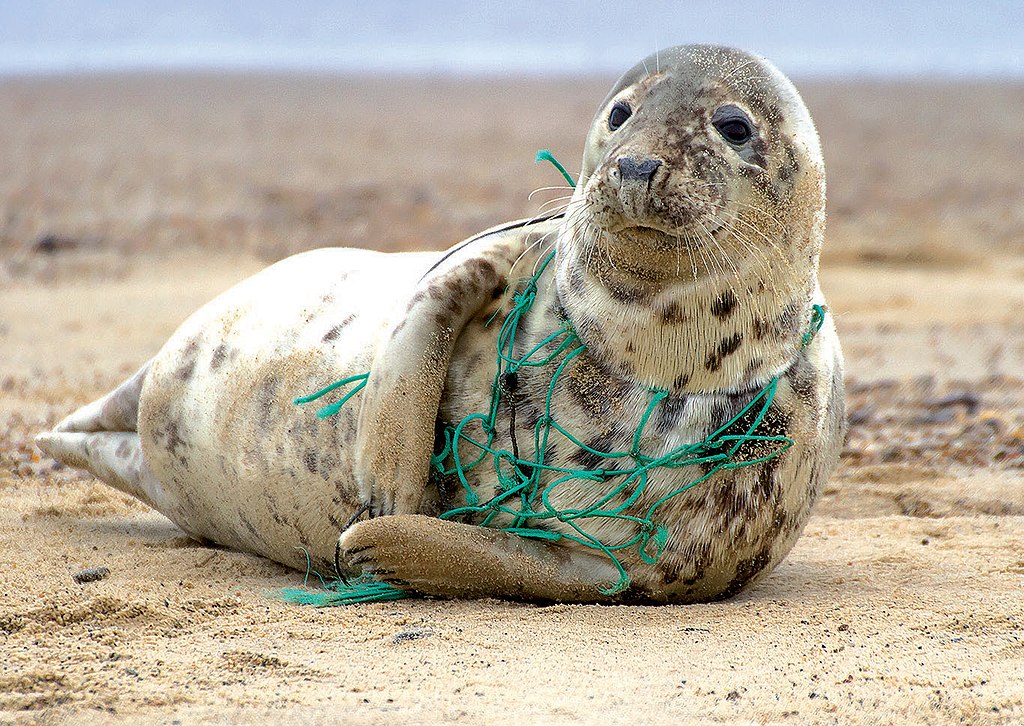Plastic is everywhere in our lives – it is in water bottles, phones, cars, glasses, shoes and much more. But the world has been recklessly discarding plastic after use, where in 2020, 11 million tons of plastic ended up in the ocean. This leads to catastrophic consequences not only for marine ecosystems, but for wildlife in the ocean.. With COVID-19 not going away any time soon, which has already led to a surge of single-use face masks and plastic takeaway boxes, more plastic continues to be produced and disposed of, piling on the problems that plastic pollution creates for wildlife.
—
How Serious is Plastic Pollution in the Ocean?
In 2020 alone, 370 million tons of plastic was produced, a number that is expected to continue to rise as the fossil fuel industry plans to increase plastic production by 40% over the next decade. It is estimated that 3% of the produced plastic will ‘leak’ into the ocean from coastal nations, meaning that around 11 million tons of plastic made its way into the ocean last year.
Studies estimate there are now 15–51 trillion pieces of plastic in the world’s oceans with over 1.3 millions tonnes floating on the ocean surface – about 40% of the ocean surface – which means that every single square mile of the surface ocean is affected by plastic pollution. It is found in offshore environments that macroplastics from several decades ago – even as far back as the 1950s and 1960s – persist. Some estimation even proves that some plastic takes at least 400 years to break down.
Problems Plastic Pollution Creates for Wildlife in the Ocean
There have been a number of problems this rate of plastic pollution has created for wildlife in the ocean. Millions of animals are killed by plastics every year, from birds to fish to blue whales, often from eating and getting caught in plastic.
In 2019, a turtle hatchling, no bigger than the palm of a hand, was found dead with 104 pieces of plastic in its stomach.
Animals easily mistake floating plastic garbage for food and consume them. In a new study, researchers found that the number of species contaminated with plastic has reached a new high. Alarmingly, they found that 1,557 species worldwide, including many endangered ones, have been documented to have ingested plastic. While in many cases, microplastic, which are tiny plastic particles that are less than five millimetres long, pass through animals’ digestive systems and are expelled without consequence, plastics have also been found to have blocked digestive tracts or pierced organs. Animals can choke, sustain internal injury and die – or starve by thinking they’re full from eating plastic. Plastic ingestion can also reduce the storage volume of the stomach, making it impossible for the animals to eat.
You might also like: 10 Plastic Pollution in the Ocean Facts You Need to Know
Scientists have found plastic fragments in literally hundreds of species, including 86% of all sea turtle species, 44% of all seabird species, and 43% of all marine mammal species, reflecting how the amount of garbage in our oceans has rapidly increased in the past 40 years. These numbers are predicted to increase to 99% by 2050 if nothing is done to slow down plastic pollution.
To make things worse, tests have confirmed plastic creates liver and cell damage and disruptions to reproductive systems, prompting some species, such as oysters, to produce fewer eggs. It means that the reproduction ability of the animals that survive and continue to consume plastics will fall as well, leading to a drop in the population of different species. Moreover, animals that ingest plastic will transfer the material up the food chain to bigger fish and marine mammals, harming and killing more and more animals in the process.
Aside from ingesting, marine mammals can also get tangled up in plastic. Large amounts of plastic debris have been found in the habitat of critically endangered Hawaiian monk seals, including in areas that serve as pup nurseries. Similarly, entanglement in plastic debris has led to a rise in injury and mortality rates in the endangered Steller sea lions, with packing bands the most common entangling material. Seals, whales, turtles, and other animals have also been found strangled by abandoned fishing gear.
This is not a problem exclusive only to wildlife. Many humans consume seafood as well, and the harmful and toxic plastic in fish will likely enter the human digestive system, thus harming the human body. In other words, the plastic humans dump into the sea will eventually come back, creating a full cycle. Unless the world collectively does something about it, more animals and humans will be affected and harmed.
What Can We Do?
It is near impossible for us to cut down our plastic usage to zero. However, simply reducing the amount of plastic we send for the landfill is essential in protecting the environment and wildlife. Recently, a report from the World Economic Forum said that reusing just 10% of our plastic packaging could translate to halving the annual plastic waste entering our oceans. Upping the share of reusables to 40-70% of our packaging would also prevent 185-320% of ocean plastic pollution and 50-85% of landfilled plastics.
Reducing plastic is much easier than you think; simply reusing and recycling plastic items such as bags and bottles can help redirect large amounts of plastic towards landfills, therefore lowering the risk of plastics leaking back into the ocean.
It may seem that these little acts make minimal effect on the vast world, but as long as you take the initiative to change your lifestyle little by little, you can already help countless animals. Your efforts can help alleviate the aforementioned problems plastic pollution creates for wildlife, and even improve the entire ecosystem.
Featured image by: Wikimedia Commons

















